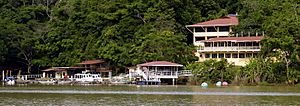Barro Colorado Island facts for kids
Barro Colorado Island is a special island found in the middle of the Panama Canal. It sits in a big, man-made lake called Gatun Lake. This lake was created in 1913 when the Chagres River was dammed.
When the lake filled up, most of the tropical forest was covered by water. But some hilltops stayed above the water, forming islands. Barro Colorado Island is one of these. It is about 15.6 square kilometers (6 square miles) in size.
This island was made a nature reserve by the U.S. Government on April 17, 1923. Since 1946, the Smithsonian has managed it. They also look after five nearby peninsulas. Together, these areas are called the Barro Colorado Nature Monument. This monument covers 54 square kilometers (21 square miles).
Barro Colorado Island is one of the most studied tropical forests in the world. The Smithsonian Tropical Research Institute (STRI) has a research center right on the island. Scientists there study tropical forest ecosystems, which are like natural communities of plants and animals. The island's diverse ecosystem has not been changed much by humans. This makes it a perfect place for scientists to study nature. Only the very largest animals disappeared from the island after the lake was flooded in 1914. Many studies have looked at how the types of plants and animals on the island have changed over time.
Hundreds of scientists come to Barro Colorado Island every year to do their research.
Contents
Discovering Island Life
Many important books and documentaries have featured Barro Colorado Island. In 1978, Thomas Croat wrote a book called Flora of Barro Colorado Island. It listed all the different plant species found there.
Later, in 1999, Egbert Giles Leigh published Tropical Forest Ecology: A View from Barro Colorado Island. He first visited the island in 1966 and still spends a lot of time there. In 2002, Elizabeth Royte wrote The Tapir's Morning Bath. This book tells stories about the lives and work of the scientists on the island.
The National Geographic Channel also made a documentary about the island in 2007. It was part of their series World's Last Great Places: Rain Forests. The part about Panama, called Panama Wild: Rain Forest of Life, showed scientists from the Smithsonian's Tropical Research Institute. It also highlighted how different species survive and work together in this rich ecosystem.
Studying Forest Changes
The 50-Hectare Plot
In 1980, scientists set up a special 50-hectare (about 124-acre) area on Barro Colorado Island. This area is called a forest dynamics plot. Researchers from STRI and Princeton University created it.
The first count of trees in this plot happened in 1982. They recorded every tree and shrub that was more than 1 centimeter (about half an inch) thick. They found about 240,000 plants from 303 different species!
Scientists have counted the plants in this plot every 5 years since 1985. This helps them study how the forest normally changes. They can also see how big events, like El Niño weather patterns, affect the forest.
Another similar plot was set up in Malaysia in 1987. This allows scientists to compare how two different tropical forests change over time.
Visiting the Island
You can visit Barro Colorado Island, but you need to plan ahead. The Smithsonian Tropical Research Institute (STRI) controls who can go there.
To visit, you must make a reservation with their staff and arrange for a tour. Tours usually include a boat ride to and from the island. They also feature a 2–3 hour guided hike. You'll get lunch and a chance to visit the museum. During the hikes, you might spot many animals. These include monkeys, anteaters, different kinds of birds, and interesting insects.
Special Rules for the Island
U.S. federal law has a special rule for Barro Colorado Island. It says that the island's natural features must "be left in their natural state for scientific observation and investigation." This means the island should stay wild and untouched for scientists to study. The only exception is during a "declared national emergency."
See also
 In Spanish: Barro Colorado para niños
In Spanish: Barro Colorado para niños



